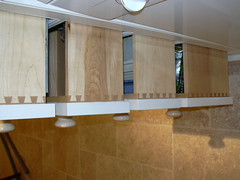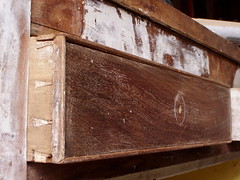 |
 |
The value of antique furniture is greatly determined by its authenticity. It’s important to make sure that the item you’re interested in is the real deal and not just a reproduction made to look like an antique. We offer a few tips on things to look for when shopping for antique furniture.
Type of Wood Used
The wood furniture is made from can provide a significant amount of information to distinguish between an antique and reproduction. Furniture makers from earlier time periods typically used multiple types of wood in each piece because of the high cost to use expensive woods. Check areas of the furniture that aren’t usually seen, such as the back and drawer interiors, for secondary wood. If they have the same wood as the rest of the piece or manufactured wood, such as press board or plywood, it’s probably not an antique. Early furniture makers would typically use more common woods for these sections.
Condition of the Wood
A few signs that furniture is newer include consistent color, lack of patina, machine-cut moldings/carvings, and modern screws or nails. Things like mortise-and-tenon joints, wood pegs, hand-cut dovetails, and rose head nails are typically found in antique furniture. However, keep in mind that manufacturers may use older nails or wood in a reproduction to make the piece look like an antique.
Wooden furniture shows signs of age through shrinkage of the wood, splits, and seam separation (Craddock, 2016). Wood shrinks across the grain—but not with it—so an antique circular table will not have a perfectly round shape (Ross, 2009). If it does, it’s likely a reproduction or someone replaced the tabletop.
The veneer of an antique and reproduction may also vary. Since about 1900, veneers have become thinner (Henderson, 2015). The earlier furniture makers utilized wider boards with the thicker veneer.
Natural Materials
The materials used in upholstery were natural until the 1920s when synthetic fibers first made an appearance (Blavin, 2010). You will typically find an antique with original upholstery stuffed with horsehair and other natural material.
Signs of Wear and Age: Are They Real or Manufactured?
While reproductions are often made to look older than they are, you can still discern the differences between the looks of aging. Reproductions tend to have consistent signs of wear. Authentic antiques, on the other hand, will have varying degrees of wear due to years of use. For example, the underside of a chair arm should not look like it has the same level of wear as the area where your hands typically rest (Blavin, 2010). Another place to look for signs of wear is under the feet. Drawer runners should also be showing signs of age from the drawers being opened many times (DIY Network).
Asymmetry & Irregularity
Antique pieces aren’t going to be perfectly symmetrical because they were made by hand rather than with machines; slight changes in size or shape will help you know that the piece was handmade (Bilis, 2016). Carvings aren’t going to be perfectly symmetrical either; craftsmanship done by hand will have some imperfections (Blavin, 2010).
While irregularity isn’t normally considered to be a good sign, it’s a key factor for antiques. Dovetail joints and older screws do not have a perfect shape when they’ve been made by hand for an antique piece. If a dovetail joint has perfect lines and edges, the piece is more than likely made by a machine (Bilis, 2016). In the images below, you can see that the machine-made joints are more uniform than the hand-cut joint. Antique furniture made with hand planes, saws, and chisels will have surfaces that are going to feel slightly uneven while the surfaces of more recently made furniture will be smoother.
 |
|
|
(CC BY-NC-ND 2.0) by jabenaki
|
“Draw Boxes” (CC BY-SA 2.0) by P.Flint |
Patina
One of the biggest factors is the patina, which is the layers of polish, wax, dust, etc. that are found on surfaces (Henderson, 2015). This is one of the hardest things to fake, but furniture manufacturers may try to imitate patina through heavy staining. If you look at parts that aren’t intended to be seen, such as underneath a table, a true antique should have raw wood that doesn’t have any signs of staining (Chatelaine’s Antiques and Appraisals Magazine).
Things to Keep in Mind
These signs don’t always guarantee that a piece of furniture is antique or modern-made. For example, an antique chair may be reupholstered so it’s no longer stuffed with natural materials. While this means the antique is no longer in its original condition, the chair is still considered to be an antique even though the value may be slightly different. The same principle applies to other types of restoration.
Reproductions are made in the style of earlier periods, but the furniture makers don’t intend to trick customers into believing the piece is older than it is. Typically, the manufacturer will add a label that details when and where it was produced. On the other hand, a fake is intended to be mistaken for the real deal so still keep an eye out for the differences described above.
References
Bilis, M. (2016). Five Ways to Tell if Furniture is Actually Antique. Retrieved from Boston Magazine: http://www.bostonmagazine.com/property/blog/2016/03/25/how-to-tell-furniture-antique/
Blavin, S. M. (2010). How to Tell Real Antique Furniture From Reproductions. Retrieved from Apartment Therapy: http://www.apartmenttherapy.com/how-to-distingu-127076
Chatelaine’s Antiques and Appraisals Magazine. (n.d.). Fake and Reproduction Furniture. Retrieved from http://antiques-art-collectibles.com/collectible/furniture/fake_furniture.html
Craddock, D. (2016). What is the Difference Between Reproduction & Antique Furniture? Retrieved from Velvet and Honey: http://www.velvetandhoney.com/blog-unique-furniture-and-homewares-perth/2016/4/26/what-is-the-difference-between-reproduction-antique-furniture
DIY Network. (n.d.). Tips on Distinguishing a True Antique From a Reproduction. Retrieved from http://www.diynetwork.com/how-to/make-and-decorate/decorating/tips-on-distinguishing-a-true-antique-from-a-reproduction
Henderson, A. (2015). How to tell the Difference between Reproduction and Antique Furniture. Retrieved from Maple Leaf Restoration: http://mapleleafrestoration.co.uk/how-to-tell-the-difference-between-reproduction-and-antique-furniture/
Oakley, B. (2011). 1 easy way how to tell a reproduction piece of furniture from a real antique. Retrieved from Oakley Restoration & Finishing: http://www.oakleyrestoration.com/1-easy-way-how-to-tell-a-reproduction-piece-of-furniture-from-a-real-antique/
Ross, J. G. (2009). How to Discern a Fake Antique. Retrieved from Chubb Collectors: http://www.chubbcollectors.com/real-deal

